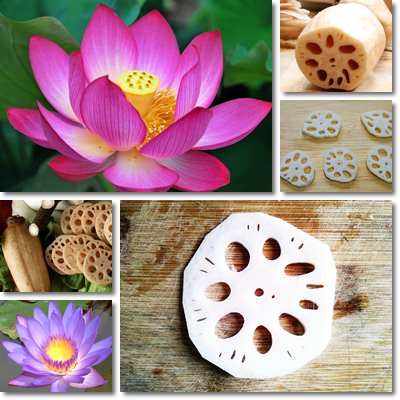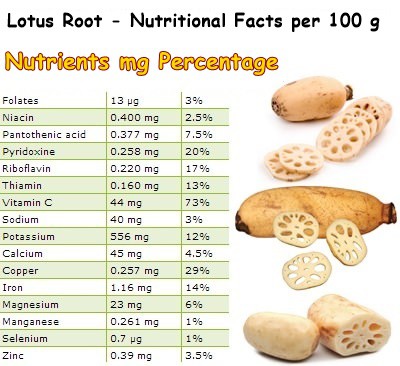Although it may seem exotic, the lotus root (Nelumbo nucifera) is not only a beautiful addition to one’s culinary experience, but also provides a variety of rather impressive health benefits. It is a good source of essential nutrients such as copper, iron, potassium, vitamin C, thiamine, riboflavin and pyridoxine and contains small amounts of vitamins B5, B9 and B3. If you live nearby an Asian market or have access to fresh lotus roots, you can enjoy all the benefits this exotic vegetable has to offer.
What does lotus root look like?
Well, lotus root is an elongated, plump, pale brown culinary root vegetable which ranges in size from 10-20 cm to 1.2 meters. Impressive right? Although we call it lotus root, it is actually the stem of the lotus plant which rises from the muddy bottom of a river or pond to support the gentle flowers resting peacefully on the leaves. Being an aquatic plant, lotus root should never be eaten raw because there is a high risk of parasitic infection.
The preferred cooking methods include frying, steaming or boiling and the tender rhizomes make an excellent salad or side dish. On the outside, lotus roots are plain-looking vegetables with a pale brown skin and a plump, elongated appearance. However, on the inside, the vegetables appear perforated so that when you slice them they look somewhat like beautiful, milky white snowflakes or, if you ask me, like the stout of a watering can.

Can you eat lotus root raw?
Although lotus root is edible raw (and even tastes a little better than raw potato), experts strongly advise cooking it prior to consumption. Eating raw lotus root can increase the risk for parasite infections (Fasciolopsis buski) due to potentially unsanitary growing conditions such as the presence of pig farms nearby which can lead to cross-contamination, use of manure for soil fertilization and so on.
What does lotus root taste like?
Except for a mild bitterness and sweet starchiness, the root of the lotus plant doesn’t really taste like anything. However, what is great about it is that it is pleasantly crunchy and tender at the same time. Whether you simmer it for several hours or stir-fry it, it preserves its crisp texture, yet remains tender, somewhat creamy, provided you choose it right.
How to choose good lotus root
For the best culinary experience, go for younger lotus roots. The younger the root, the tenderer it is. Young lotus roots are smaller in size and have a pale brown, almost whitish skin. Old lotus roots are not only significantly bigger, but also tend to turn dark brown. Also, avoid lotus roots with spots and blemishes, soft parts and any other similar defects. A firm, medium-sized root should meet all of your culinary demands.

What are the benefits of eating lotus root?
What is lotus root good for? Find out below what are the top 8 health benefits of eating lotus root:
Helps relieve constipation naturally
Lotus root has 4.9 g of dietary fiber/100 g of root. Dietary fiber adds bulk to stools, facilitating their passing through the intestine and thus relieving constipation. When increasing your fiber intake (to about 20-25 g per day) remember to drink plenty of water so the fiber can work its magic.
Promotes digestive health
Some forms of dietary fiber initiate fermentation processes within the digestive tract from which healthy gut bacteria may profit. Also, by relieving constipation and supporting intestinal motility, foods rich in dietary fiber such as lotus root promote digestive health.
Has cholesterol-lowering properties
The dietary fiber in lotus roots binds to the fat in the ingested food and prevents it from being absorbed at the intestinal level along with nutrients. This indirectly contributes to lower blood cholesterol levels, significantly reducing LDL (bad) cholesterol. The cholesterol-lowering properties of various foods are directly proportionate to one’s fiber intake.
Offers antioxidant protection
Lotus roots contain great amounts of vitamin C (73% of the RDA) as well as copper (29%) and other phytochemicals with antioxidant properties. Vitamin C and copper both offer protection against free radical damage buildup and subsequent chronic diseases.

Supports nervous system activity
A rich source of B vitamins, notably thiamine, riboflavin and pyridoxine, lotus roots help support nervous system activity. For instance, thiamine, or vitamin B1, helps improve memory and concentration and strengthens nerves. B vitamins also ensure good energy levels by means of an appropriate carbohydrate synthesis.
Antiviral and antibacterial properties
Lotus root owes its impressive antibacterial and antiviral properties to its high vitamin C content. A high intake of vitamin C stimulates immunity and thus helps improve and reduce the frequency of viral and bacterial infections.
Lowers high blood pressure
Being a good source of potassium (12%), lotus root contributes to regulating body fluids and blood pressure levels. Including potassium-rich foods as well as magnesium-rich foods (for the heart muscle and blood vessels) in your diet should significantly improve cardiovascular health.
Promotes health of hair and eyes
The good amounts of copper in lotus root (29%) contributes to healthy hair and eyes. Copper deficiency will, in time, lead to premature hair graying and iris discoloration, two major signs of aging.
Conclusion
If you want to grow your own lotus, you will definitely need underwater space and patience. Although you can grow it from seeds, experts advise using roots instead. Even in this case, the first floating leaves will emerge after a minimum of 5-6 months. If you already have an artificial pond, then you might give this a try. Not only will you get beautiful lotus flowers to flatter your garden, but you can also eat the roots, flower stems and seeds of the plants.
